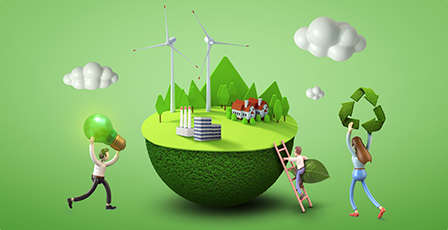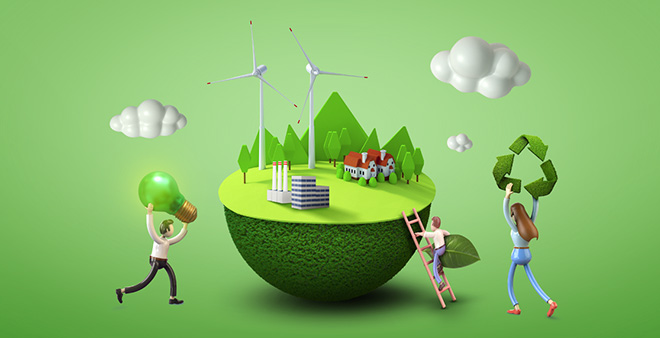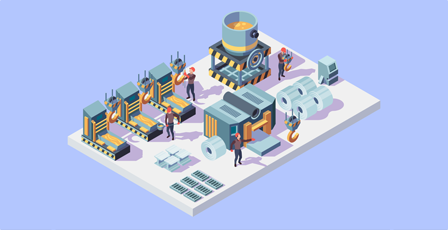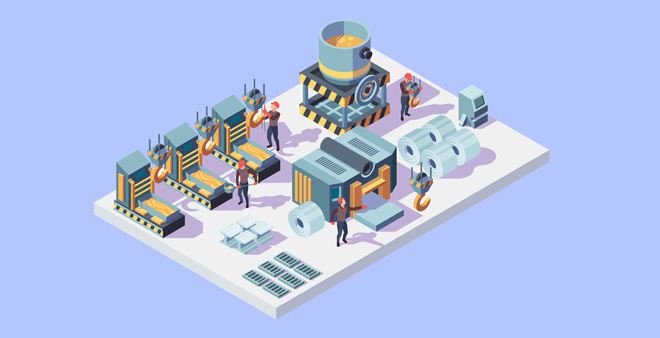ESG
Environmental
LS MnM's unrivaled technological prowess in the field of metal materials.
We are now taking a leap forward as an eco-friendly metal materials company based on our top-notch environmental management system.
Policy & Strategy
Raw Materials and Circular Economy LS MnM procures 1,700kt of copper concentrate annually, which is a crucial raw material required for copper production, from mining companies located worldwide. Copper concentrate is a virgin material mined from nature, and it is transformed into an electrolytic copper cathode product with a purity of 99.99% through a smelting process. We are contributing to the development of a circular economy by implementing various measures. At LS MnM, we are gradually increasing the usage of recycled raw materials every year, as well as recovering copper waste and electronic waste generated at the end of the product cycle. Moreover, we established a new facility to increase the usage of copper scrap and improve sampling and preprocessing efficiency. In order to increase the usage of E-Scrap, we installed two heating furnaces on our site and secured an additional 30kt/y of Printed Circuit Board(PCB).


Eco-friendly Resource Utilization of By-products LS MnM makes various efforts to recycle and commercialize as many by-products possible that are generated from the smelter during the production of electrolytic copper. We aim to indirectly contribute to the circular economy and environmental preservation by recycling byproducts that could otherwise cause cause environmental pollution is discarded.
Sulfuric Acid Copper concentrate, a crucial raw material for producing electrolytic copper, contains sulfur(S), which generates sulfur dioxide(SO2) during the refining process. When SO2 is released into the atmosphere, it can cause pollution and also have harmful effects on human health. To mitigate these risks, LS MnM collects and processes these SO2, converting it into sulfuric acid products that are used as an essential material in various industries such as fertilizer, textile, medicine, steel, metal, and food.
Steam LS MnM utilizes surplus reaction heat generated from the copper mine oxidation reaction during the smelting process to produce steam. Since 2005, we have been selling steam to Hankuk Paper, and in 2008, we expanded to S-OIL. Currently, we supply steam for four companies, including pier operators such as Jeongil, Onsan, and Hyundai. By providing steam as a heat source to these companies, we ultimately contribute to the reduction of carbon emissions.
Slag Slag is a significant by-product generated during the copper refining process, which LS MnM processes and sells as LSFerrosand. This material is a chemically stabilized and exhibits excellent aggregate properties, making it an ideal substitute for natural aggregate. By promoting the use of LS-Ferrosand, we indirectly contribute to the conservation of natural resources. As a participant in the Molten Slags, Fluxes, Salts Conference, we actively support technology development related to slag recycling. Since the generation of slag is unavoidable as long as the smelting business is in operation, effective treatment of slag is directly linked to business continuity. We recognize slag as a resource rather than waste, and recovering valuable metals from it is an important research topic that requires extensive global research beyond LS MnM. Going forward, we will expand our network and take the lead in recovering resource from slag.
Performance
Efforts to Increase Recycling Raw Material Processing LS MnM is taking steps to increase the efficiency of its sampling and pre-processing by building a new copper facility near the company’s site. By doing so, we aim to increase the usage of copper scrap, which undergoes weighing, sampling, and classification before being stored in the facility. The copper scrap is then compressed into a standardized size and transferred to the converting furnace in Smelting Plant 1 and Smelting Plant 2 for further processing. In addition, we have conducted a research to increase the usage of e-scrap and have found that insertion and extraction of valuable metals are advantageous under specific sintering conditions. To take advantage of this finding, we have installed two kiln furnaces at our copper facility and were able to secure an additional 30kt/y of PCBs.


Recycling Resources At LS MnM, we view waste as a valuable resource that can be recycled. We are actively contributing to the preservation of natural resources by increasing the recycling rate.
Packaging While most of LS MnM's products do not require packaging, minimal and recyclable packaging is used for the 41 products that may change shape or property during delivery, as well as for customers who specifically request it. Secondary raw materials undergo canning process to reduce loss during transportation and facilitate input. Empty drums used at this time is a packaging container previously used to contain oil and lubricants. These drums are typically sold as scrap metal after being one use, but we selects and uses recycled drums that have been washed before being sold as scrap metal and have become defective during the production process.
Recycling of Waste Assets/Waste LS MnM places a strong importance on the recycling of waste assets and waste generated during its operations. Copper jackets used for heat exchange and equipment protection are regularly repaired or replaced, and are regularly repaired or replaced, and the waste generated from this process is recovered in the converting furnace, instead of being disposed of outside. Similarly, waste busbars generated at the end of their lifespan are put into the converting furnace and recovered as valuable resources. Recycled sand refers to the foundry sand used for producing molds in casting, which has been reprocessed and is reused. We also use this recycled sand in our copper smelting process as a flux to form slag and to separate impurities such as iron(Fe) in molten metal. Additionally, waste generated from downstream industrial production processes, which involve melting and processing copper, often includes copper. This waste is transformed into a secondary raw material through pretreatment at a recycling company, which is later procured and utilized by LS MnM in its smelting operations.
Reprocessing Factory Waste LS MnM is committed to reprocessing factory waste, including the copper-rich substance known as revert that is produced during the refining process of copper. After undergoing sorting and separation process, the revert is then reprocessed in the smelting process. In the electrolytic refining process, we use the deoxidization process to maintain the copper concentration level in the electrolyte solution. Once the copper is extracted from the electrolyte and formed into Cu-cement, it is then transported and Smelting Plant 2 where it is reprocessed in the smelting furnace.


